Highlights of thirty-year experience of CO2 laser use at the Florence (Italy) department of dermatology
- PMID: 22593693
- PMCID: PMC3347966
- DOI: 10.1100/2012/546528
Highlights of thirty-year experience of CO2 laser use at the Florence (Italy) department of dermatology
Abstract
The CO(2) laser has been used extensively in dermatological surgery over the past 30 years and is now recognised as the gold standard for soft tissue vaporization. Considering that the continuous wave CO(2) laser delivery system and the newer "superpulsed" and scanned CO(2) systems have progressively changed our practice and patient satisfaction, a long range documentation can be useful. Our experience has demonstrated that the use of CO(2) laser involves a reduced healing time, an infrequent need for anaesthesia, reduced thermal damage, less bleeding, less inflammation, the possibility of intra-operative histologic and/or cytologic examination, and easy access to anatomically difficult areas. Immediate side effects have been pain, erythema, edema, typically see with older methods, using higher power. The percentage of after-treatment keloids and hypertrophic scars observed was very low (~1%) especially upon the usage of lower parameters. The recurrence of viral lesions (condylomas and warts) have been not more frequent than those due to other techniques. Tumor recurrence is minor compared with radiotherapy or surgery. This method is a valid alternative to surgery and/or diathermocoagulation for microsurgery of soft tissues. Our results are at times not consistent with those published in the literature, stressing the concept that multicentric studies that harmonization methodology and the patient selection are vital.
Figures

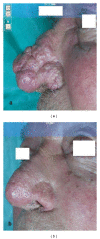

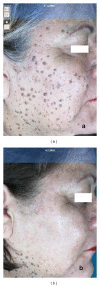

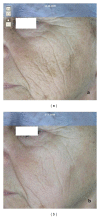
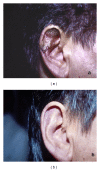
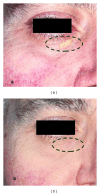
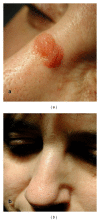

Similar articles
-
Standard guidelines of care: CO2 laser for removal of benign skin lesions and resurfacing.Indian J Dermatol Venereol Leprol. 2008 Jan;74 Suppl:S61-7. Indian J Dermatol Venereol Leprol. 2008. PMID: 18688106
-
Laser treatment of hypertrophic scars, keloids, and striae.Dermatol Clin. 1997 Jul;15(3):419-29. doi: 10.1016/s0733-8635(05)70451-4. Dermatol Clin. 1997. PMID: 9189679 Review.
-
[Utilization potential of the CO2-laser in dermal changes].Handchir Mikrochir Plast Chir. 1996 Nov;28(6):328-33. Handchir Mikrochir Plast Chir. 1996. PMID: 9064259 German.
-
Applications for Laser in Veterinary Dermatology.Vet Clin North Am Small Anim Pract. 2025 Mar;55(2):251-284. doi: 10.1016/j.cvsm.2024.11.005. Epub 2025 Jan 3. Vet Clin North Am Small Anim Pract. 2025. PMID: 39755502 Review.
-
Treatment of hypertrophic scars and keloids using an intralesional 1470 nm bare-fibre diode laser: a novel efficient minimally-invasive technique.Sci Rep. 2020 Dec 10;10(1):21694. doi: 10.1038/s41598-020-78738-9. Sci Rep. 2020. PMID: 33303965 Free PMC article.
Cited by
-
Efficacy and Safety of Carbon Dioxide Laser System in the Treatment of Scalp Sebaceous Adenoma With the Use of a New Scanner Unit.J Med Cases. 2023 Jul;14(7):251-254. doi: 10.14740/jmc4132. Epub 2023 Jul 31. J Med Cases. 2023. PMID: 37560545 Free PMC article.
-
Fractional CO2 Laser vs Fractional CO2 with Topical Platelet-rich Plasma in the Treatment of Acne Scars: A Split-face Comparison Trial.J Cutan Aesthet Surg. 2017 Jul-Sep;10(3):136-144. doi: 10.4103/JCAS.JCAS_99_17. J Cutan Aesthet Surg. 2017. PMID: 29403184 Free PMC article.
-
A Multimodal Approach to Laser Treatment of Extensive Hypertrophic Burn Scar: A Case Report.Am J Case Rep. 2023 Jun 5;24:e939022. doi: 10.12659/AJCR.939022. Am J Case Rep. 2023. PMID: 37276191 Free PMC article.
-
Rhinophyma Treatment by Copper Vapor Laser With the Computerized Scanner.J Lasers Med Sci. 2019 Spring;10(2):153-156. doi: 10.15171/jlms.2019.24. Epub 2019 Feb 25. J Lasers Med Sci. 2019. PMID: 31360385 Free PMC article.
-
Fractionated Carbon Dioxide Laser Resurfacing as an Ideal Treatment Option for Severe Rhinophyma: A Case Report and Discussion.J Clin Aesthet Dermatol. 2019 Jan;12(1):24-27. Epub 2019 Jan 1. J Clin Aesthet Dermatol. 2019. PMID: 30881573 Free PMC article.
References
-
- Tanzi EL, Lupton JR, Alster TS. Lasers in dermatology: four decades of progress. Journal of the American Academy of Dermatology. 2003;49(1):1–31. - PubMed
-
- Fitzpatrick RE, Goldman MP, Ruiz-Esparza J. Clinical advantage of the CO2 laser superpulsed mode: treatment of verruca vulgaris, seborrheic keratoses, lentigines, and actinic cheilitis. Journal of Dermatologic Surgery and Oncology. 1994;20(7):449–456. - PubMed
-
- Alster TS, Kauvar ANB, Geronemus RG. Histology of high-energy pulsed CO2 laser resurfacing. Seminars in Cutaneous Medicine and Surgery. 1996;15(3):189–193. - PubMed
-
- Reid R. Physical and surgical principles governing carbon dioxide laser surgery on the skin. Dermatologic Clinics. 1991;9(2):297–316. - PubMed
-
- Vaderhobli RM, White JM, Le C, Ho S, Jordan R. In vitro study of the soft tissue effects of microsecond-pulsed CO2 laser parameters during soft tissue incision and sulcular debridement. Lasers in Surgery and Medicine. 2010;42(3):257–263. - PubMed
MeSH terms
LinkOut - more resources
Full Text Sources
Miscellaneous

